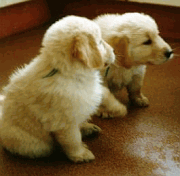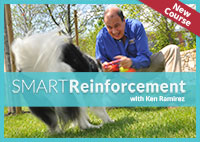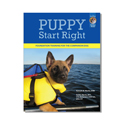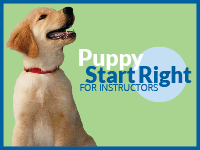How soon can you begin training puppies? As soon as their eyes and ears are open, according to some breeders, who are using the clicker on whole litters of pups, even before they are weaned. Why would you want to do that? Well, the clicker means good things are coming. The puppy that makes that connection can then learn that its own actions sometimes cause those clicks that lead to treats. And the puppy that makes that discovery has a big start on a happy future.
Here's how it works. As soon as supplemental feeding begins, the litter owner clicks as the pan of food is set down among the puppies. Some people click just once, and some click as each puppy nose actually reaches the food. Police officer Steve White, who breeds German shepherds, begins clicking even earlier, every time the dam goes into the litter box to nurse her babies-surely a very important event for the pups.

After some exposure to the clicker, start taking each puppy away from the litter for a short session on its own. Click, and treat. A dab of pureed baby food meat on the tip of your finger makes a great treat, even for the tiniest breed. Then pick something the puppy happens to do, such as lifting a front paw, and click as the paw goes up. It may take ten or more clicks before the puppy begins lifting the paw on purpose; but then you'll be amazed at how enthusiastic the puppy becomes. "Hey, look! I can make that huge person give me food, just by doing THIS!"
Choose any simple behavior at first: it doesn't need to be something useful. A sit, spin, wave, play bow, back up, or lie down, are all possibilities. You can teach all the puppies the same behavior, or, if you have them identified individually, teach them each something different. Don't try to coax or lure your students into a particular behavior; you want each puppy to discover that its own actions make you click. This teaches the puppy a major life lesson: "I like to find out what people want me to do." That discovery won't happen if the puppy just learns to wait to be shown what to do.
How much time does this take, in your busy life? Two or three clicker lessons, of no more than two to five minutes each, are enough to develop some cute little behavior. No need for a lot of drilling; once a puppy learns what to do for a click, it won't forget.
More importantly, these brief lessons can convert a puppy of five weeks or so from an oblivious blob into an eager, observant learner.
You can capitalize on this awakened state in many ways. For example, when people come up to the litter box, do the puppies rush over and leap on the walls, begging for attention? Probably. So use clicker sense and make a new rule-a rule for puppies and for family and visitors, too: only puppies that are sitting get petted, or lifted out of the pen. It doesn't take long to get the whole litter sitting; and you can click them all at once, for doing that. Now, when supper comes, the puppies will have to sit and be clicked before the dish goes down. Instead of repeatedly and unintentionally reinforcing jumping up, a behavior most pet owners really hate, you are building a bunch of pups with better manners than that, even before they leave home.
"Come when called" is another skill the whole litter can learn with clicks and treats, and a fun one for children to teach. Two or three children can take turns calling a puppy back and forth between them, clicking and treating when the puppy goes to the child that called. You're going to give your buyers a puppy that already has a head start on this important behavior.
How far can you go? Training with absolutely no corrections, just informative clicks and enjoyable treats, you can go a long way, even with a baby. When my last border terrier puppy arrived on the airplane, a long-distance purchase bought sight unseen, she was just nine weeks old. I brought her home, set her down, and gave her a little toy. She picked it up, carried it to me, and dropped it at my feet. Surely this is an accident? I thought. I tossed it. She went and got it, brought it back, and dropped it again. Using clicks and treats, the breeder, as a treat for me, had taught this tiny puppy a nice retrieve!
Breeders with clicker-trained litters usually give their buyers a demonstration of what the puppy has learned, a simple list of instructions or suggestions for using the clicker (several lists are available free on line: search for clicker training sites) and of course a clicker or two. People love taking home a puppy that already knows a trick; what a smart dog! And your early work starts them off with an attentive and cooperative pup that is ready to learn more-a puppy that has a far better chance of fitting in to its new world than a puppy starting from zero.
Melinda Johnson, a long-time breeder of soft-coated wheaten terriers, began clicker training litters several years ago. Like many breeders, Melinda will always take a dog back if it doesn't work out in its new home. Melinda reports that since she started clicking litters, her return rate has dropped to zero; and her file of letters from thrilled and happy owners has grown enormously. "Smartest, most attentive dog I've ever had." "A laugh a minute, how did we get along without her?" These puppies still have a lot to learn, of course. But they start their new lives knowing how to learn, and ready and eager to learn more. Click!








That's the magic!
You're right, to an extent. At first, the puppy won't know what happened. But at around the third or fourth click, you can actually see the lightbulb go off in their head. They learn to stop and think about what they were doing, and that's part of the huge possibilities that come from clicker training.
It's pretty natural that they will start to put this together. Just think- if every time you opened a door, someone handed you a twenty dollar bill, you'd start opening every door you could find. The same principle applies.
If you look around the site some more, especially under the Getting Started section, you'll find several descriptions of how this all works. Keep reading, it's good stuff!
Clickers to teach tricks?
How would you teach a puppy to do sit, lie down or even paw with the clicker? The article says that you click when the pup is in the middle of the action such as when they lift the paw but how would you make them repeate that if they only did it by accident and they don't know what they did? How could you train them to sit or lie down without doing it for them to show because if they happen to be sitting and you click and give them the treat how are they supposed to know what to do on command if you say sit and they dont know what to do unless you click and then you can't teach it more tricks? How can you get results when you only click when the pupy does it and might not think of doing what they just happend to do again? Please reply soon please i'm very confused!!!
Post new comment